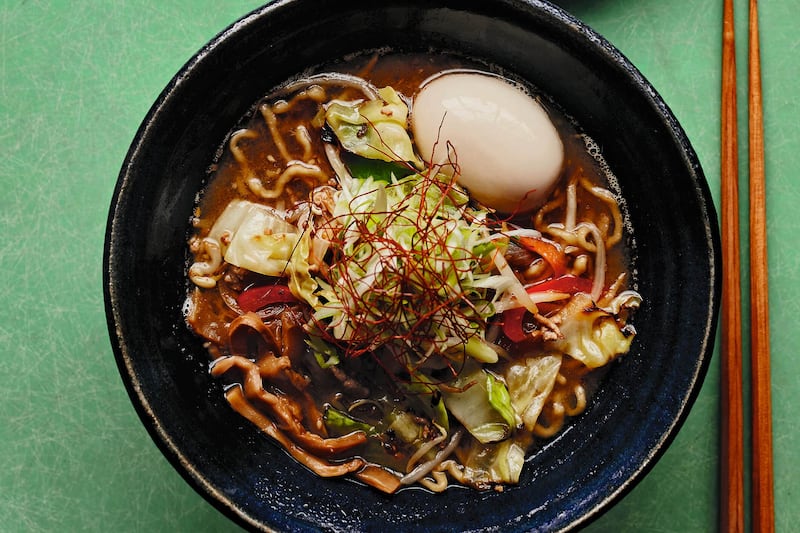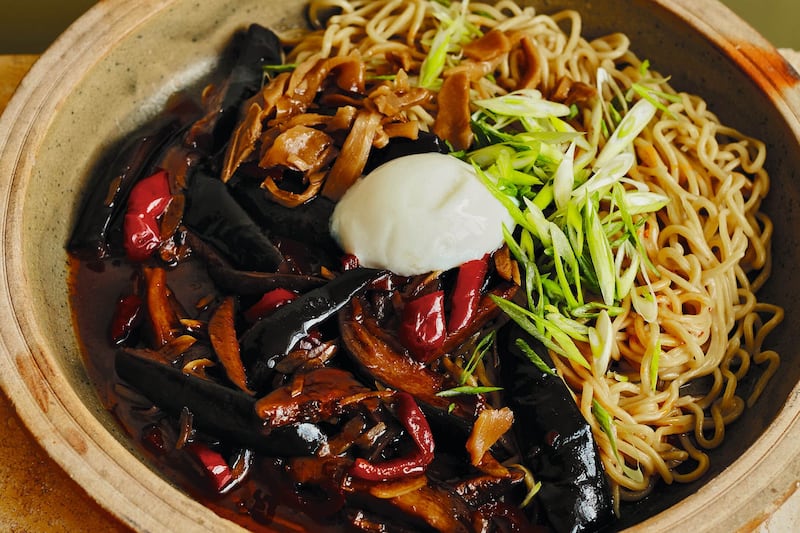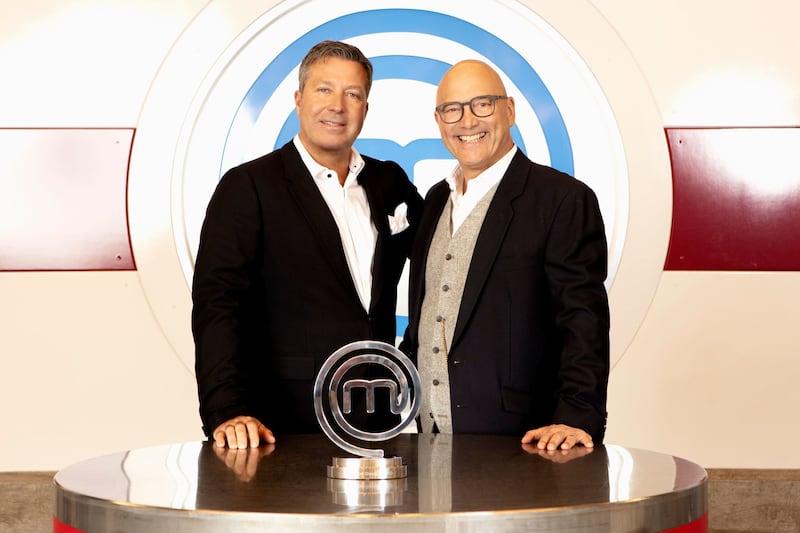THE first time he tried sushi, American chef Tim Anderson, who runs Japanese soul food restaurant Nanban in London's Brixton, wasn't keen.
"Sushi is the first Japanese food everybody tries and I've never understood why," he says, when we meet in Nanban's kitchen, where he's set to teach me some basics. "I really didn't like the nori [seaweed] – the flavour or texture – it was an acquired taste. But I was really into soul food – tempura, fried rice. I loved noodles from the beginning, and the thing that blew my mind when I first tried it was tonkatsu [breaded pork cutlet] ramen."
Sushi is not on the menu at Nanban – it's all about the ramen and soul food – but there are recipes for spicy tuna rolls and salmon avocado rolls in his new book, JapanEasy, in which Tim dispels the myth that Japanese cooking is complicated or requires a larder full of special ingredients.
"I'm really proud of my first book, Nanban," says the 2011 MasterChef winner, "but it was never going to be a huge bestseller because the recipes were so obscure and difficult, whereas this book was really fun to write and I think it's going to do a better job of actually getting people to cook Japanese food."
We're chatting while Tim prepares nasu dengaku – miso-glazed aubergines – which involves cutting a crosshatch pattern in the flesh of a halved aubergine, which is then deep-fried, slathered with sweet miso sauce and popped under the grill. It takes minutes to prepare and cook and tastes sweet and salty and delicious.
"It's a really simple thing – and it goes with all types of food," he says. "Like, if you're having lamb chops, there's no reason you can't have that as your side."
Westerners have two preconceptions that stop them from cooking Japanese food, believes Tim.
"One is they don't think they can get the ingredients, which isn't true. You're not going to go to a Tesco Metro and find everything you need, but a big Tesco will absolutely have all the ingredients you need to cook the vast majority of Japanese food, and you can get everything online," he says.
"Also, I think people think you have to make a beautiful Japanese meal, but really Japanese home-cooking is just as humble and unpretentious as any other home-cooking."
Tim grew up in Wisconsin, where "we don't have a lot of Japanese food". It was watching one of the first televised cooking competition shows, Iron Chef, (which was dubbed into English and became a cult hit in America) when he was 13, that got him into Japanese food – and he moved to LA to study Japanese history.
After graduating, he taught English in Japan for two years, before moving to England in 2008, marrying wife Laura and opening Nanban, in 2015. At 26, Tim became the youngest winner of MasterChef, wowing the judges in the final with his Kyushu-style pork ramen with truffled lobster and gyoza.
:: JapanEasy: Classic & Modern Japanese Recipes To Cook At Home by Tim Anderson, photography by Laura Edwards, is published by Hardie Grant, priced £20. Below are two recipes from the book for you to try.
RAMEN WITH SCALLOPS, BACON AND EGGS
(Serves 4)
1 leek, white part only, finely shredded;
8 rashers of streaky bacon; 40g or 3tbsp butter;
4 big fat scallops or 12 little scallops;
Splash of white wine or sake;
1.2L chicken or fish stock; 11/2tsp mirin;
2tsp dashi powder (or more or less, to taste);
Salt; 4 portions of ramen noodles;
4 eggs, poached or soft-boiled, halved;
2tsp chilli oil (or more or less, to taste – optional);
Toasted sesame seeds; 50g pea shoots;
Freshly ground black pepper
Cover the shredded leek in very cold water. Cook the bacon in a frying pan over a medium heat until brown and crisp. Drain on kitchen paper and add the butter to the pan. Add the scallops and cook for two to three minutes on each side (or one minute for little ones), until nicely browned, then remove from the pan. Add the white wine or sake to the pan and cook off the alcohol.
Scrape any bits off the bottom of the pan, then tip everything into a saucepan. Add the stock and mirin, and bring to the boil. Add the dashi powder and some salt, taste and adjust the seasoning as necessary. Slice the scallops horizontally into thirds (or leave whole if little), and roughly chop the crispy bacon.
Bring a separate saucepan full of water to a rolling boil and cook the ramen according to the package instructions. Pour or ladle the broth into deep bowls, drain the noodles well and place in the broth. Drain the shredded leek. Top the noodles with the eggs, shredded leek, chopped bacon, sliced scallops, chilli oil, if using, sesame seeds, pea shoots and some black pepper.
CURRY RICE
(Serves 2-4)
1 onion, cut into small chunks;
2 carrots, peeled and cut into wedges;
400g floury potatoes, peeled and cut into bite-sized chunks;
1/2 cauliflower, broken into bite-sized florets;
4 portions of cooked rice (300g uncooked);
For the curry sauce:
4tbsp oil; 1 large onion, roughly chopped;
2cm piece of fresh ginger, peeled and finely sliced;
1 green chilli, roughly chopped;
2 garlic cloves, peeled; 2 tomatoes;
1/2 Golden Delicious or similar apple, peeled and roughly chopped;
1/2 banana; 30g mild Madras curry powder;
2tbsp garam masala; 750ml chicken or beef stock;
60g butter; 6tbsp plain (all-purpose) flour;
2tbsp ketchup; 2tbsp soy sauce; Salt
For the sauce, combine the oil, onion, ginger, chilli, garlic, tomatoes, apple, banana, curry powder and garam masala in a food processor and blitz to a paste. Pour this into a saucepan and cook on a medium-high heat, stirring often, until the mixture begins to caramelise and the spices become aromatic. Add the stock and bring to the boil.
Meanwhile, melt the butter in a separate saucepan and whisk in the flour. Cook on a low heat for about eight minutes, stirring constantly, until the roux thickens and turns a golden brown colour. Ladle the curry mixture from the other pan into the roux, a little at a time, whisking constantly to incorporate. Add the ketchup and soy sauce.
Cook the mixture until it's quite thick, then transfer to a blender or use an immersion blender to puree until smooth. Taste and adjust the seasoning with salt. Place the onion, carrots and potatoes in a saucepan and cover with water. Bring to the boil, add the cauliflower and reduce to a simmer. Cook for about 10 minutes, until everything is tender. Drain and return to the pan; pour in the curry sauce. Bring everything back to a simmer and serve with the rice.








